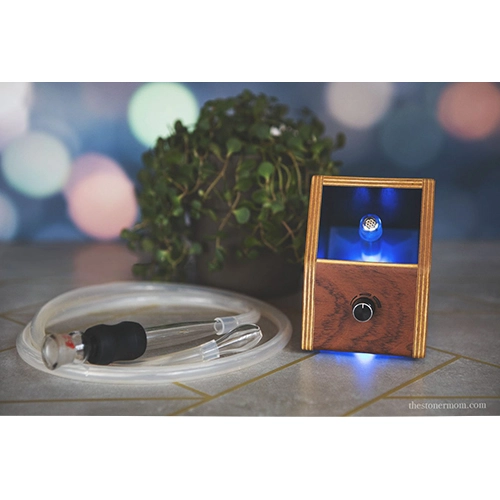Vaporizers: What are they and their Different Types
Do you know about the types of vaporizers available, or that some types of vaporizers are better than others in specific ways? Do you need help deciding which vaporizer is right for you? You may have seen "vape pens", "portable herb vaporizers", or "desktop vaporizers" that you plug in at home. If knowing what makes these vaporizers different is confusing, don’t worry, you’ll understand the pros and cons by the end of this article, and be in a better position to choose the best one for you!
Vaporization: What is it anyway?
Vaporization is generally the process of turning a liquid into a gas using warming methods such as conduction or convection, as opposed to combustion where the product is burned (through pyrolysis), releasing byproducts as a result of burning. An herbal vaporizer is a device that releases the moisture from an herbal substance in the form of a vapor mist that can be inhaled. This is typically achieved with gentle heating of the herbs or their extracts.
Vaporizers can be classified based on their form factor and how they heat the material to be vaporized. Some vaporizers are designed to evaporate only oils, such as waxy or oily extracts of herbs.
When vaporizers are designed for herbs they extract the oils and moisture content and deliver a fine mist to the user, leaving the solid structure of the plant behind.
Keep reading to find out which vaporizer is right for your application.
Conduction vs Convection (and Radiation)
The most basic classification of vaporizers is in how they heat the material |
Conduction
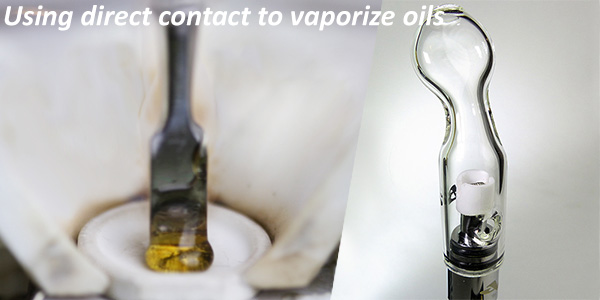
In a conduction vaporizer, the material sits in direct contact with a hot surface, usually a heated metal or ceramic bowl.
Pros
Conduction is best for heating oils. A dab pen works by conduction. The wire heating element transfers heat to oils and evaporates them rapidly.
Cons
Conduction vaporization is not efficient with dry herbs. Since herbal material does not transfer heat quickly, the edges of the herb will overheat and cause a burned taste when they touch the hot surface. The heat does not get to the center of the herbs so conduction vaporizers are wasteful.
Most conduction vaporizers are small portable handhelds and don’t produce much vapor.
Convection

In Convection vaporizing, warm air is drawn through the material, allowing the user to inhale the moisture content
Pros
Convection vaporizing is the best way to inhale the essence of herbs. The heated air is drawn through the herbs, evaporating the oils and moisture content. The hits generally taste like fresh herbs.
Convection vaporizers can get the material close to the maximum temperature before burning, but without producing combustion.
Cons
Convection vaporizers are not particularly effective with wax concentrates because solid materials do not let the air pass through. You could inhale concentrates in a convection vaporizer and get a great taste, but the evaporation is gradual instead of all at once.
Radiation
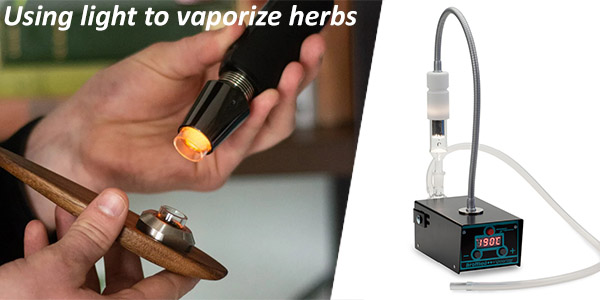
Radiation vaporizers use light energy to heat material.
Using light to heat herbs is a unique and rare vaporization method. Examples are the OG vaporizing brand Aromed and a new portable from PRRL Labs, both which use a mix of convection and radiation to heat herbal material.
|
Portable Vaporizers vs Desktop Vaporizers |
Portable vaporizers
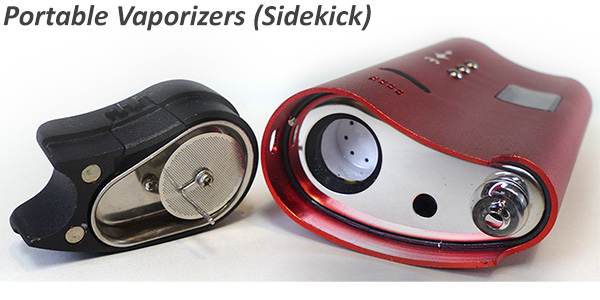
Portable vaporizers typically use the Conduction method for oils and are most often battery-operated and hand-held. Some portable vaporizers use a flame to operate. Most portables work well for dabs and e-juice, but portables for dry herbal material (using the convection method) run out of batteries often and struggle to vaporize the herbs.
Pros
Portables are convenient for taking out of the house. Portable vaporizers most often don’t need a cord except for charging.
Cons
Portable vaporizers are limited to their battery life, which is often only a few bowls. The portables that run for longer are larger, making handheld use clunky and they give poorer hits.
Battery and space constrain the design of portable vaporizers, sacrificing the quality of vapor for portability. Most portables rely on the conduction heating method to preserve battery life and do not produce much vapor.
Desktop vaporizers
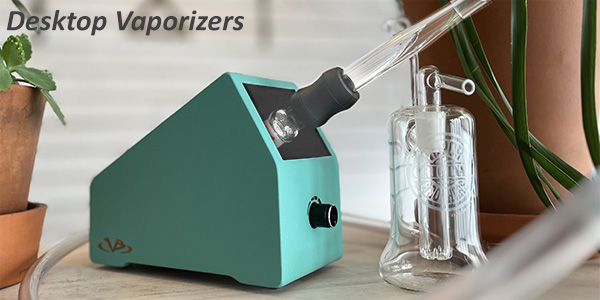
Desktop vaporizers like the VB1 use Convection method and generally sit on a flat surface and plug into the wall. Desktop vaporizers are not held back by battery or space constraints and have fewer compromises in their design.
Pros
Desktop vaporizers can give large, satisfying vapor hits and are generally capable of giving stronger and fresher-tasting vapor, leaving the user more satisfied.
Due to being plugged into the wall, desktop vaporizers never lose their effectiveness and eliminate the worry of limited battery life. Well-designed desktops like the VB1 can be left on indefinitely, always ready for the next hit.
While portable vaporizers tend to lose effectiveness or wear out within a year of use, desktop vaporizers can be maintained and work well year in and year out.
Although modern "high-tech" vaporizers can be quite expensive, they do not produce better results for greater investment.
Cons
Desktops need to be unplugged to move. You can carry your desktop to another location and have a great time, but only where you can find power and a safe setting to locate the vaporizer.
Desktops generally have more parts to keep track of and clean. They make up for the lack of portability with a better vapor experience. |
A deeper dive into Conduction vs. Convection
As previously mentioned, vaporizers can be classified based on how they use heat to produce vapors. The two primary forms of vaporization are conduction and convection. Conduction and convection machines have pros and cons associated with both methods. Your ideal vaporizer will depend on what exactly you want out of the vaporizer.
Conduction
Vaporization via conduction is achieved by applying a material straight onto a heated surface. The heated surface varies from a ceramic bowl to a metal coil. Depending on what substance you want to vaporize, conduction vaporization can be a quick, efficient option. However, this method works best with oily substances as they vaporize most efficiently on heated surfaces.
The quality of vapor is highly dependent on the quality of the oil used as well as the material used as a heated surface. Certain metals are known to outgas toxic materials at a high temperature, so before buying any vaporizer, it’s important to be able to know the materials being used inside your vaporizer.
Conduction vaping does not work well for dry herb material. The oils transfer heat well and evaporate easily in conduction, but herb does not transfer the heat as efficiently. This leads to a burnt taste and increased risk of combustion as the material closest to the surface gets increasingly hotter while the rest of the material remains cool. Often, material in the center will remain not vaporized while material on the edges may even combust. This leads to a vapor with less taste and more waste!
Conduction devices can produce huge large clouds since the material is in direct contact with the heating element, but the taste can become quite harsh.
Convection
Convection vaping is a popular method of vaporizing dry herb materials and it is how our flagship model the VB1 produces its unmistakable vapors.
Vaporization via convection is achieved by pulling heated air through the material you want to vaporize. A convection oven or an air fryer is similar in concept. They both use heated air to produce their desired effect; for an air fryer, crispy sweet potato fries, for the Vaporbrothers VB1, tasty pure vapor!
Convection vaporizing also conserves products very efficiently. Because the vaporization effect is gradual, the product is able to fully release its moisture and oils as it gradually builds heat.
Convection vaping does not work as well for oil-based substances. It is still possible with the proper equipment to use oils in a convection-style vape, but the gradual vaporization is not optimal for said oils and provides a different taste profile than conduction vaporizing would.
Anecdotally, vaporization produced via a top-notch convection vaporizer like the VB1 is less harsh on the lungs than other methods of vaporization and combustion
What makes the Vaporbrothers VB1 the best Convection Vaporizer?
Our very own “VB1”, the original desktop dry herb vaporizer established in 1999, utilizes convection vaporization to produce the highest quality, tastiest vapor you’ll ever try.
- We at Vaporbrothers recognize that vaporizing is a unique experience and unique experience calls for unique equipment.
- We started our company 22 years ago with all of our health in mind, so our vaporizers are designed to last and remain as safe as possible throughout their usage.
- The Vaporbrothers VB1 has perfected the gentle art of conserving products; it can get the product as hot and vaporized as possible without combusting the material. The VB1 uses a 16mm heating element and whip, allowing for more vertical surface area for the heated air to interact with the material. There are also more narrow options that amplify this effect, allowing for even more efficient conservation of the product.
- At Vaporbrothers, all of our components are designed to handle the temperature they experience without outgassing chemicals.
- While some convection vaporizers take upwards of 15 minutes to come to temperature, the VB1 consumes about 5 minutes in its initial heat-up.
- VB1 uses a gentle heat process via the ceramic and glass heater. This allows many tasty compounds to be saved in the vapor whereas they are lost in conduction vaping or combustion.
- Vaporbrothers uses Ceramic and glass as our preferred materials of use due to their non-reactive properties. The Vaporbrothers' VB1 is the best-tasting convection vaporizer because the air is gently heated over a broad ceramic and glass surface.
- Vaporbrothers VB1 uses only the best quality materials and has some of the highest safety certifications in the industry.
- The Vaporbrothers VB1 has the best value in the industry, providing more taste and less waste than vaporizers costing three times as much.
- You can see our our VB1 products here.
A Caution
Certain metals are known to outgas toxic materials at high temperatures. Before buying any vaporizer, it’s important to be able to know the materials being used inside your vaporizer. A poorly designed vaporizer, such as the cheap products produced overseas, will overheat its own parts for its lifetime and is not the safest for inhalation.
Conclusion
Which type of vaporizer to own is largely up to your personal needs and where you want to use the vaporizer. A vaporizer can be a helpful way to achieve medicinal and recreational effects from herbal products. Vaporizing has fewer associated health risks than combustion.
Customers who desire to use mainly oil-based substances are better off with a conduction-style vaporizer. However, if getting the best-tasting vapor from dry herbs while wasting fewer products appeals to you, a convection vaporizer like the VB1 is the best all-around vaporizer.
We would love to hear your thoughts on this blog post. You can direct any comments or questions to us here.
Thank you for taking the time to read our blog!
Happy Vaping!
